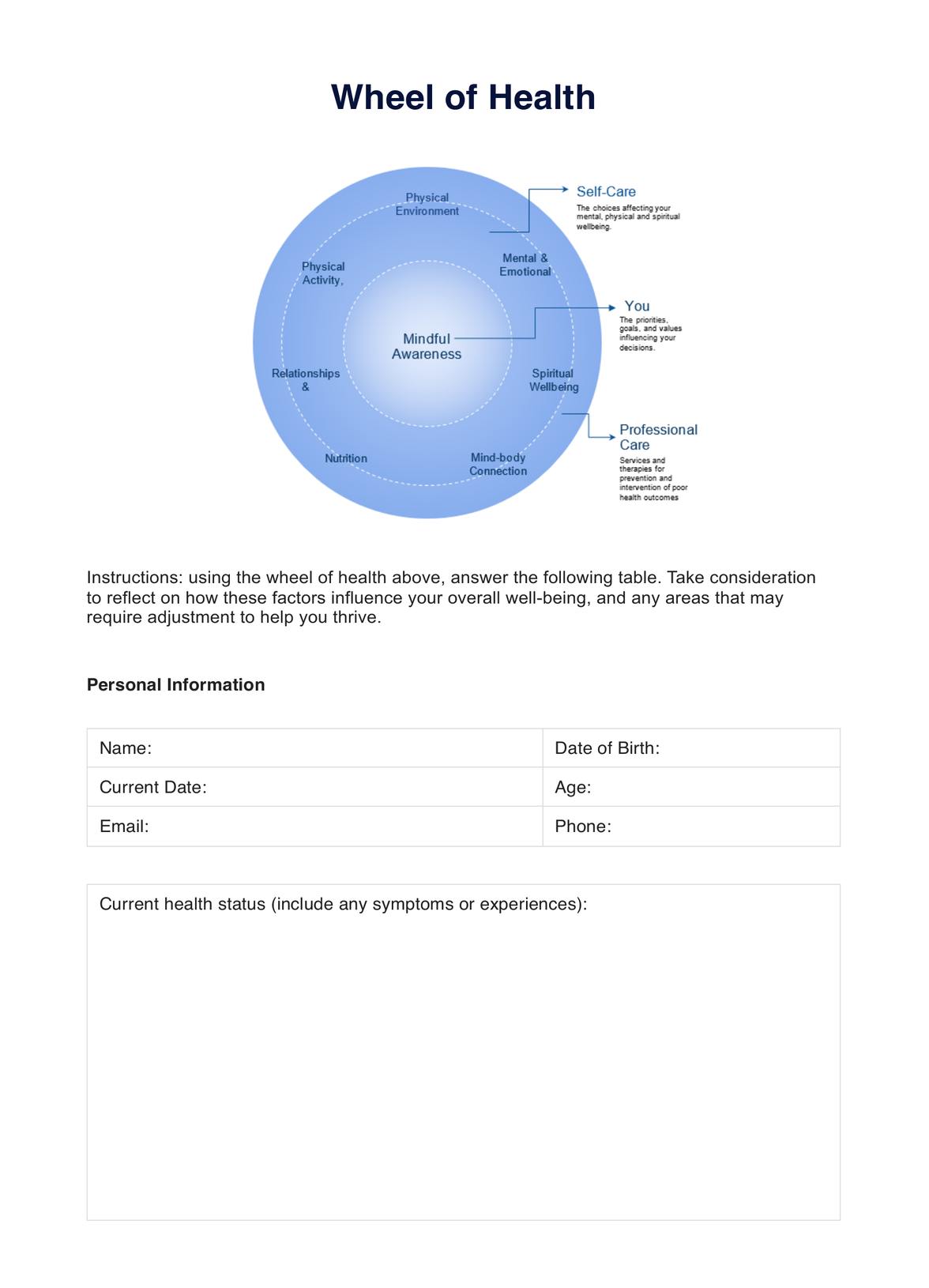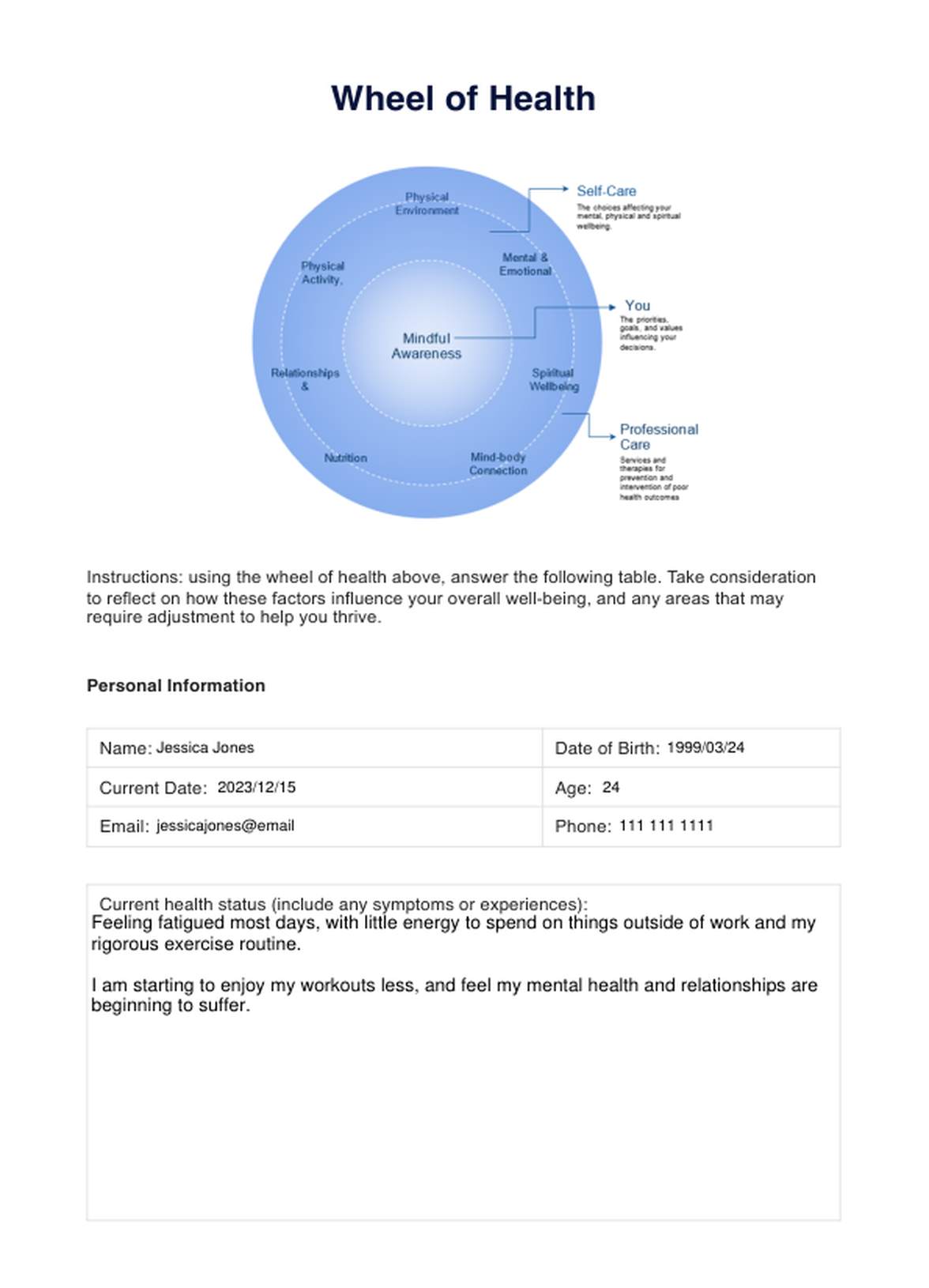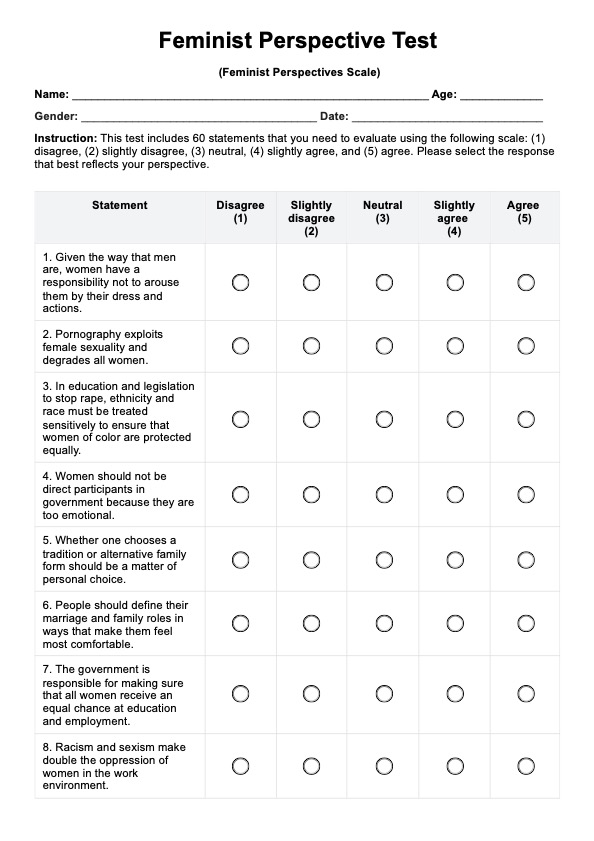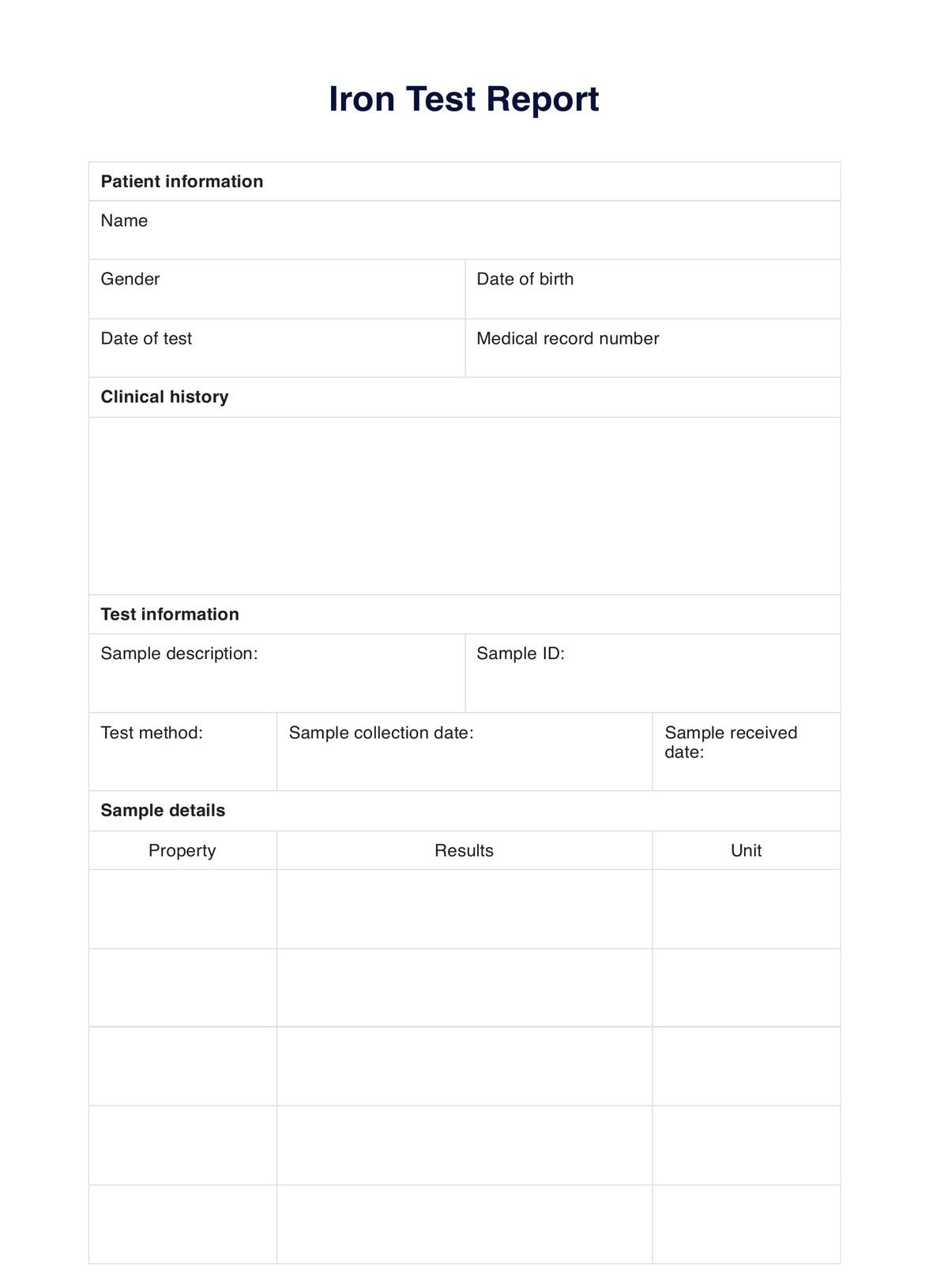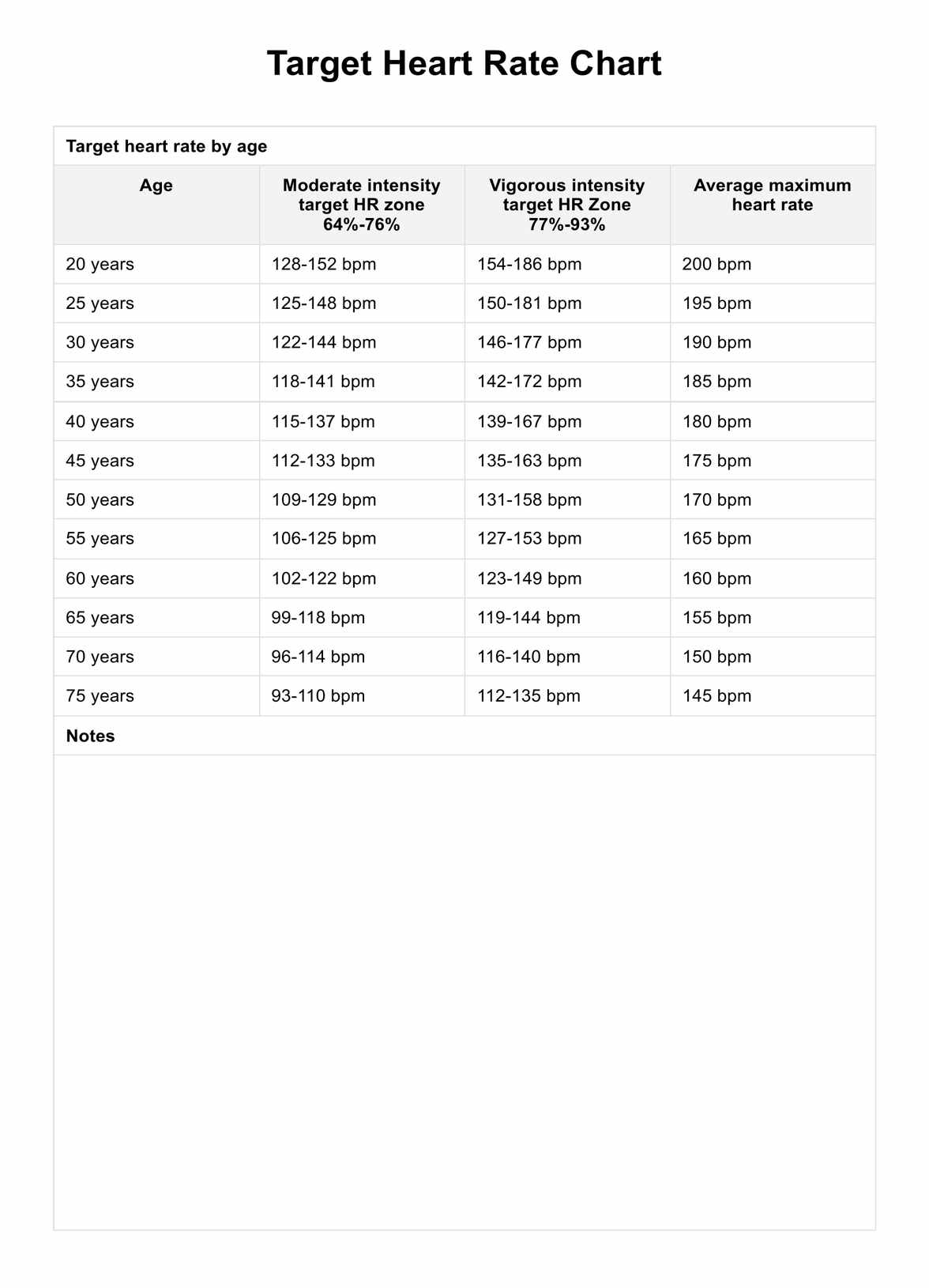Wheel Of Health Template
Are you seeking a more holistic approach to enhancing overall health and well-being? Using our Wheel of Health Template, you can kickstart your journey.


What is a Wheel Of Health template?
The Wheel of Health (WOH) template is a visual tool that reminds individuals of the various layers influencing health and lifestyle (Gonzales, n.d.). This resource comes from Duke Integrative Medicine and works to help individuals and health practitioners achieve a stable health and well-being equilibrium (Sidi, n.d.).
According to the World Health Organization (WHO), health involves establishing physical, mental, and social well-being (Gonzales, n.d.). Each area of the wheel focuses on one specific aspect of life that influences health (Gonzales, n.d.). When an area is perceived to be out of balance or negatively impacts an individual, their overall health and well-being may be compromised.
By using the WOH, individuals and practitioners can identify when an area is becoming out of sync and make life adjustments to restore equilibrium (Sidi, n.d.). The seven dimensions of the wheel include:
- Physical activity, exercise, and rest
- Mental and emotional wellbeing
- Nutrition
- Physical environment
- Relationships and communication (social)
- Spiritual wellbeing
- Mind-body connection
The wheel also highlights the roles of mindful awareness, self-care, and professional care as foundations for achieving balance (Duke Integrative Medicine, 2010).
- Mindful awareness emphasizes that individuals must centralize themselves and that they are catalysts to positive growth.
- Self-care is implemented in priorities, lifestyle, and habits, which can reflect aspects of health and well-being. In recognizing the role of self-care, individuals can begin making positive changes to support healthier life balances.
- Professional care highlights the role of prevention and intervention within healthcare. Aspects of health regarding disease prevention and early detection often require the support of health providers such as physicians, health coaches, and psychologists to help individuals stay healthy.
By using the WOH, individuals and health professionals can collaborate to make life adjustments to achieve a sustainable balance that centralizes health and well-being.
Wheel Of Health Template
Wheel Of Health Template Example
How does it work?
To show you how our template works, we have broken down the process into the following steps, which may guide your client consultations:
Step 1: Obtain the template
The template can be accessed here or downloaded for a physically printed copy by using the link below:
Step 2: Interpret the template
Become familiar with the template, paying close attention to the seven aspects of health and well-being and the role of mindful awareness, self-care, and professional care in establishing a balance.
Practitioners need to consider that balance may differ between clients. Thus, the template should only be used as a reference in client consultation.
Step 3: Client consultation
Present the template to clients and discuss how the resource may enhance health. Discuss the various aspects and their roles in creating a sustainable balance for wellbeing.
Step 4: Collaboration
Work with your client to define what balance looks like at baseline for each aspect and identify the contributing factors. For example, healthy social relationships may look like attending a family dinner weekly.
In this step, clients must lead the direction, with practitioners offering suggestions when necessary.
Step 5: Reflection
With your clients, reflect whether the client feels they are currently at a balance. If they are, identify ways in which this can be sustained. If they are not, identify the aspects influencing this and work together to develop strategies and life adjustments to change this.
Step 6: Ongoing monitoring
Providing ongoing monitoring and support is essential to help clients achieve a sustainable balance. This may require revision or updates to the WOH template as circumstances and needs change.
When would you use this template?
This template can be used in various practices seeking to enhance client health. Taking a holistic approach, the resource focuses on the various aspects influencing health that can be used by practitioners individually or in practitioners working in a team. Practitioners such as life coaches, general practitioners, or psychologists may find this template useful for the following:
Barrier identification
The template may help clients identify both direct and indirect barriers to enhancing health. Because the template highlights the relationships between aspects, clients, and practitioners may identify how some areas may restrict potential and progress in others.
Client monitoring
This may be a resource for health professionals and clients to track progress in relation to overall health status. This may involve assessing progress in relation to life adjustments and monitoring any changes in well-being.
Health assessment
The template can be used as an assessment tool during routine checkups or annual wellness exams. Because it takes a holistic approach, it may provide information regarding health status as a whole.
Personalized health plans
Practitioners may use the template to identify areas that may require life adjustments. This may inform recommendations or strategies within the client’s overall personalized health plan. Clients and practitioners can improve overall health and wellbeing by focusing on each area.
What do the results mean?
The holistic nature of the Wheel of Health means that results can be multi-faceted and differ amongst individuals depending on the status of the several aspects in relation to health. Here are some common results and what they may mean for an individual:
- Barrier identification: In consultation, clients may identify barriers in their lives that may contribute to poor health outcomes or ill-being. This may inform life changes to enhance these areas, creating a more sustainable life balance.
- Centralization: In understanding the roles of mindful awareness and self-care, clients may recognize that they are the catalysts for positive change and rebuilding a healthier lifestyle.
- Empowerment: The template places clients at the center of the wheel to promote mindful awareness and self-care alongside seeking professional care in therapy. By recognizing their active role in their health, clients may be more empowered to make lifestyle adjustments and engage in treatment to take control of their health outcomes.
- Lifestyle adjustments: Clients and practitioners may identify areas requiring adjustments, such as through lifestyle behaviors, dietary management, or resolving conflicts in relationships.
- Enhanced health outcomes: By informing strategies or lifestyle changes, the template can help clients and practitioners develop plans that enhance overall health outcomes.
The journey to enhancing health and overall well-being can begin by accessing our free Wheel Of Health template. Our template provides information about the different areas that may be affecting health and can be customized to suit the needs and aspirations of your clients.
Research & evidence
Duke Health and Wellbeing developed the wheel of health to encourage individuals and practitioners to centralize individuals and highlight the various layers within health and wellbeing (Geiger, 2021). This encourages a broader, holistic approach to health that informs positive changes to maintain a sustainable balance in health and well-being.
It is common to assume that access and use of healthcare services have the most considerable influence on health. However, the WHO highlights that, to a large extent, health is determined by situation and environmental factors like genetics, income, and relationships (WHO, 2017). Many of these factors are often outside of the individual’s control. Thus, the WHO emphasizes that organizations, health providers, and governments must contextualize health statuses in order to identify barriers and develop well-informed interventions.
While there is little empirical evidence supporting the wheel of health, the value of this resource can be drawn in its alignment with the recommendations and theories developed by reputable sources like the WHO. By investigating broader factors, individuals and practitioners can develop a clear network of factors contributing to well-being and develop efficient interventions to address these.
In using this resource, clients may feel more empowered to take control of their health outcomes. Simultaneously, in acknowledging the broader determinants of health, practitioners are able to take a more empathetic stance in their practice. This may enhance the therapeutic relationship between clients and practitioners.
References
Duke Integrative Medicine (2010). Wheel of Health. Duke University. https://solsticehw.com/wp-content/uploads/2021/01/3D-Wellness-Care-II-Wheel.pdf
Geiger, D. (2021). Assess Your Well-Being with the Wheel of Health. DukeHealth. https://www.dukehealth.org/blog/assess-your-well-being-wheel-of-health
Gupta-Smith, V. (n.d.). Major Themes: Health and Well-Being. World Health Organization. https://www.who.int/data/gho/data/major-themes/health-and-well-being
Sidi, T. (2022). Understanding the Wellness Wheel: 7 Dimensions of Wellness. Talkspace. https://www.talkspace.com/blog/wellness-wheel/
Ocean Integreative Health Coaching, llc (n.d.). Duke Integrative Medicine. https://www.oceanihc.com/wheel-of-health.html
World Health Organization (2017). Determinants of health. World Health Organization. https://www.who.int/news-room/questions-and-answers/item/determinants-of-health
Commonly asked questions
You can easily create a template by using our Wheel of Health template as a reference. This can be done by typing into the template or downloading a PDF copy to enter information by hand.
These templates can be used for various scenarios that focus on enhancing health and well-being. Health professionals like general practitioners and health coaches may find the template useful in their client consultations, as it provides a holistic appraisal.
The templates are used to assess the various factors influencing health. Within this assessment, clients and practitioners establish what each of these factors look like when stable and healthy, developing strategies to enhance wellbeing.


